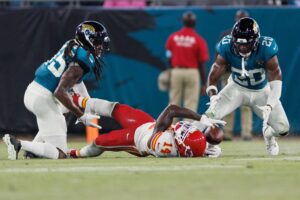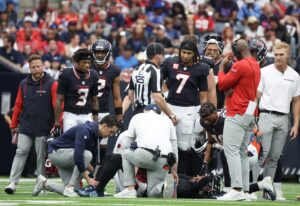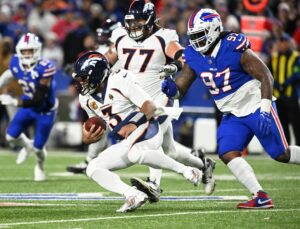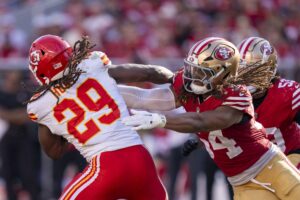Ron Rivera is guilty of dereliction of duty the longer he allows Jack Del Rio to continue running the Washington Football Team defense. Del Rio’s unit has been the most disappointing in the NFL through seven games. Forget the numbers, even though they are bad enough — last in points allowed and 29th in yards — this is a group full of big names who have failed to deliver.
Ron Rivera Can Save the Washington Football Team Defense
The much-ballyhooed front four hasn’t lived up to the hype. Nor has a secondary retooled during free agency. In a situation like this, a franchise can hardly jettison the entire playing staff, so coaches usually fall on the sword. That means it’s time for Del Rio to go.
Del Rio leaving would allow head coach Rivera to assume defensive coordinator responsibilities. He hasn’t wanted to do it, but now’s the time for Rivera to call the plays:
Ron Rivera shuts down any idea of getting more involved with defensive play-calling, which he did in Carolina as recently as 2019.
Says 4-5 plays cost WFT including two big plays on defense. Says you can't take those back, but making big scheme changes "makes no sense to me."
— Ben Standig (@BenStandig) October 11, 2021
The switch would quickly revive this defense because Rivera is an exceptional play-caller who knows how to create confusion with moving parts and disguise. Two of Rivera’s previous coaching stops, the San Diego Chargers (as they were known in 2010) and the Carolina Panthers, show how Rivera would improve Washington’s defense.
Creativity Hid Lack of Star Power for Chargers
Rivera came to the attention of teams looking for a head coach after a successful four-year spell running the defense for the Chargers. He kept his units tough despite a lack of star power. His best year was 2010 when San Diego ranked first in points and 10th in yards. Those rankings were achieved without big names like Shawne Merriman, Antonio Cromartie, and Jamal Williams.
The Chargers were unable to replace that level of talent, so Rivera compensated with creativity. He moved players around, showed pressure, and alternated coverage at will. Some of the best examples occurred during a 21-14 defeat to the Kansas City Chiefs in Week 1 of the 2010 NFL season.
San Diego’s second defensive series produced another three-and-out when Shaun Phillips sacked Matt Cassel. Rivera put two down linemen, four linebackers, and five defensive backs on the field for 3rd-and-8. The Chargers threatened a blitz through the middle, but linebacker Brandon Siler and edge-rusher Larry English both bailed into underneath coverage. At the same time, slot corner Dante Hughes blitzed off the edge. With Phillips rushing from the other side, the Chargers had a four-man rush, while English, Siler, and Kevin Burnett blanketed receivers in the middle, in front of a 4-deep zone shell.
This was a pretty basic quarters defense but with slightly different personnel, specifically, English replacing Hughes in coverage and a fake blitz to force the Chiefs to keep a tight end in to block. Phillips got to a confused Cassel and forced a punt. Rivera had created a sack just by reshuffling his players and having them show one thing before jumping into another.
It’s that kind of unpredictability Washington’s defense is missing in 2021.
Unorthodox Pressure Concepts Work
The illusion of pressure had fooled the Chiefs, but Rivera pushed the blitz button for real on another key third down. It was 3rd-and-5, and the Chargers again only had two down linemen on the field. Rivera put all four of his linebackers over the left side of the Chiefs’ formation, but he moved them around.
Outside rusher Phillips joined Stephen Cooper on the inside, while middle ‘backer Burnett stood outside English, who put his hand in the dirt. The Chargers had created an overload and duly sent the pressure when Cooper and Phillips ran a cross blitz. Cooper slanted across the left guard, while Phillips wrapped around. The latter joined English to drop Jamaal Charles for a six-yard loss.
This was a bold pressure call because Rivera showed man coverage behind the front, with only Eric Weddle as a single-high safety. Washington has struggled to take similar risks this season because the pressure has been easy to decipher. There’s no reason why rush ends like Chase Young and Montez Sweat can’t be moved around to create similar looks.
The Illusion of Pressure Confuses QBs
Like any shrewd defensive mind, Rivera knows how the illusion of pressure can baffle quarterbacks. He created a classic switch and bait the next time the Chiefs faced a 3rd-and-5. Another 2-4-5 look saw Cooper and Burnett in the A gaps threatening blitz, but the latter bailed at the snap.
Cooper blitzed the middle, while ends English and Phillips dropped into coverage. On the other side, Hughes blitzed from the slot. This was a four-man rush, with different personnel, that initially looked like an all-out blitz. There was man coverage behind the rush, and Rivera’s defenders passed off receivers beautifully. Burnett made the play when he hunted up tight end Tony Moeaki and swatted away Cassel’s pass.
Beating the Best QBs Takes Something Different
Rivera’s conjuring act created an even bigger play 11 weeks later against Peyton Manning’s Indianapolis Colts. Indy faced 3rd-and-5 deep in their own territory, prompting Rivera to surprise Manning with a seven-man pressure look.
The Chargers showed Manning a four-man line with Cooper and Burnett behind it. Rivera also had safety Paul Oliver join the box as a de facto third linebacker. Hughes was in the slot, and the secondary showed man-to-man with Weddle deep, another Cover-1 look.
Each of the linebackers cheated up into the gaps along the D-line, further reinforcing the idea of pressure. San Diego had seven potential rushers against the Colts’ offensive line, tight end Jacob Tamme and running back Donald Brown.
Manning was anticipating blitz, but Rivera had all three linebackers drop. Oliver took Tamme in man coverage, while Burnett had responsibility for the running back, leaving Copper as a robber in the middle, free to double any inside routes.
Because the Chargers had shown pressure, Brown stayed in to block, leaving Phillips free to read Manning’s eyes. Manning was hit by Antonio Garay as he threw, forcing an errant pass to land in Burnett’s grateful mitts for a pick-six. Reggie Wayne was Manning’s target on a shallow crosser, but Hughes had it covered with Cooper for support. Wayne had a step on his pursuers, but Manning never saw Burnett.
Good Schemes Turn an Average Defense into a Success
Rivera produced good defenses in San Diego without a bevy of household names. He’s facing a similar dilemma in Washington. Maybe Young isn’t destined to be fitted for a gold jacket. Maybe Daron Payne and Jonathan Allen are serviceable defensive tackles who will rarely dominate. Perhaps William Jackson III and Kendall Fuller are merely journeymen, rather than shutdown corners.
Rivera should get more involved and make this barely above-average bunch tougher to decipher.
Washington Football Team Defense Needs to be Unpredictable
Predictability is the enemy of good defense against today’s CEO-style, check-with-me quarterbacks. Unfortunately, most of the league seems to know Del Rio’s scheme front and back. He’s tried to stop the bleeding by dumbing down even further, reverting to a simple four-man rush in front of a two-deep shell. It’s not an unreasonable idea, but the best passers will savage a vanilla defense, the way Patrick Mahomes and Aaron Rodgers did to Washington.
Here’s Rex Ryan talking up the need for more variety:
"To me they are so vanilla … Aaron Rodgers is gonna be like, 'This is another team that I own.'"
Rex Ryan weighs in on the WFT defense 😳 pic.twitter.com/q2eF6eo9PO
— NFL on ESPN (@ESPNNFL) October 24, 2021
Adding Layers
Rivera can add the layers of confusion his defense will need to survive against the marquee quarterbacks left on the schedule. Chief among them is Tom Brady, whom Washington will face when the Tampa Bay Buccaneers visit in two weeks’ time.
Brady fell foul of a Rivera-coached defense when the New England Patriots lost 24-20 to the Panthers in Week 11 of the 2013 NFL season. Down by four, Brady got the ball back with 0:59 remaining and all three timeouts at his disposal. In other words, an automatic score for the GOAT.
Rivera had other ideas and flummoxed Brady with a crafty mix of coverages. The Panthers lined up in a nickel defense and showed their familiar Cover 2 zone look. This became 2-Man, man coverage in front of two deep safeties, once the ball was snapped.
Linebacker Thomas Davis stuck to Rob Gronkowski, while Luke Kuechly shadowed Shane Vereen out of the backfield. Slot corner Captain Munnerlyn clamped onto Danny Amendola.
The tight coverage forced Brady to hold onto the ball against a relentless defensive line. Charles Johnson and Greg Hardy routinely got to No. 12, moving him off of his spot and knocking him to the ground.
Each time Brady saw zone, it soon became man coverage. When he thought he had a read on the scheme, Rivera threw in a three-deep zone that completely fooled Brady and almost yielded an interception.
Maybe Rivera isn’t confident about putting Washington’s linebackers on similar islands. However, rookie Jamin Davis has range, while Cole Holcomb is a smart cookie.
Rivera’s coaching history shows how he can get more creative with this porous defense. Trying to win individual matchups with talent alone isn’t working.
Main Photo:
Embed from Getty Images






